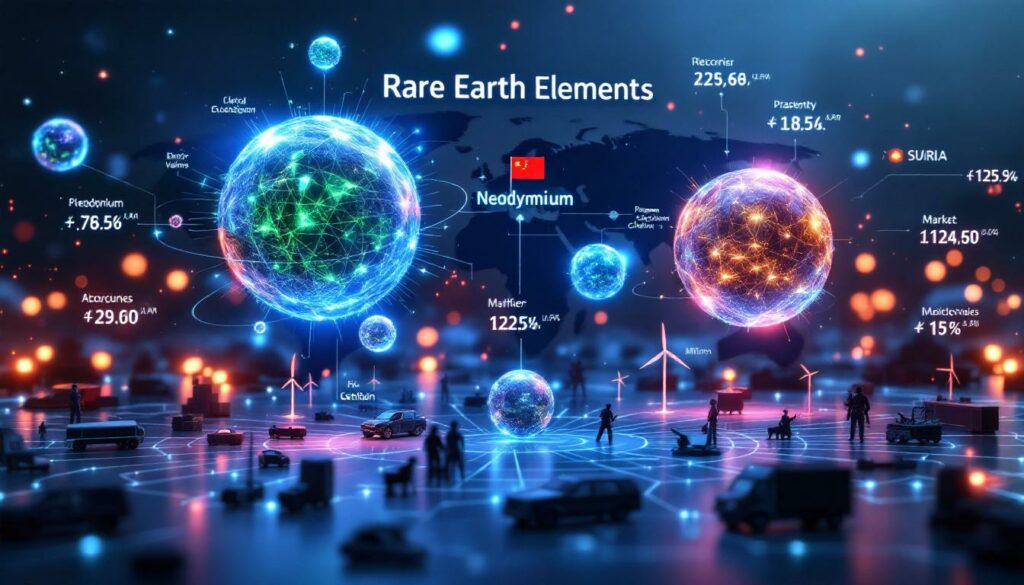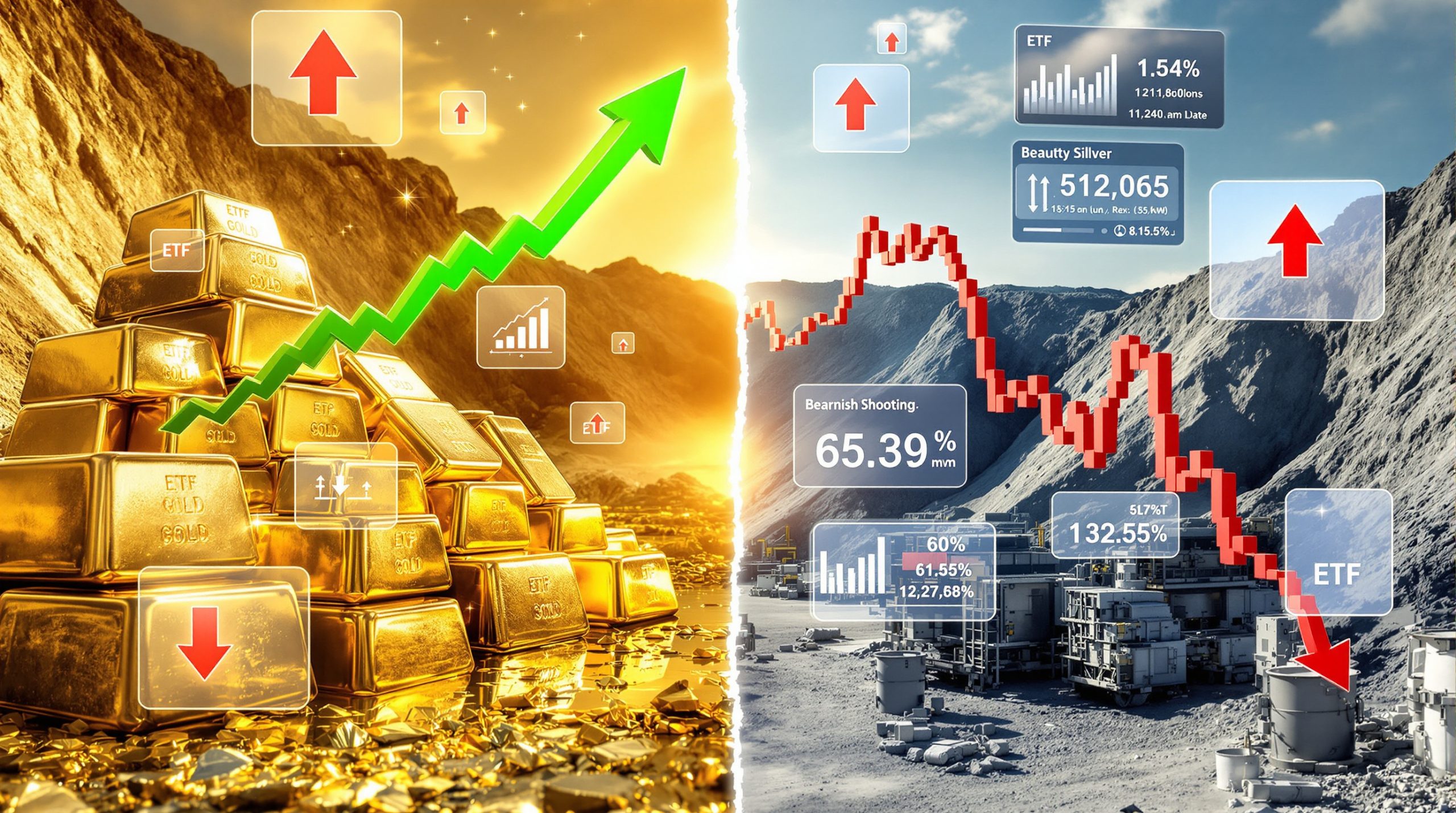What Are Rare Earth Elements and Why Are They Important?
Rare earth elements (REEs) comprise a group of 17 metallic elements that, despite their name, are relatively abundant in the Earth's crust. Their strategic importance stems from their unique magnetic, luminescent, and electrochemical properties that make them essential components in modern technologies. With China controlling approximately 80% of global rare earth processing, countries worldwide are increasingly focused on developing alternative supply chains to reduce dependency and secure access to these critical minerals transition.
The term "rare" is actually a historical misnomer dating back to 18th-century miners who found these elements in uncommon mineral formations, rather than reflecting their actual abundance in the Earth's crust. What makes them challenging is not their scarcity but their dispersed distribution and the complex, environmentally intensive processes required to separate them from surrounding materials.
"Rare earth elements represent the invisible foundation of modern technology. Without them, we simply couldn't build the clean energy infrastructure needed to combat climate change." – Geological Survey of Australia, 2025 Critical Minerals Report
The Growing Strategic Importance of REEs
The global push toward green energy technologies, advanced electronics, and defense applications has dramatically increased demand for rare earth elements. As geopolitical tensions rise and export restrictions tighten, Western nations are accelerating exploration projects, forming strategic partnerships, and implementing government initiatives to diversify REE sources, particularly in countries like Australia.
This strategic importance has been highlighted by recent supply chain disruptions, with REE prices seeing volatility of up to 200% during periods of geopolitical tension. The 2010-2011 REE crisis, when China temporarily restricted exports, sent prices soaring and served as a wake-up call for Western economies about their vulnerability to supply disruptions.
Key factors driving REE demand growth include:
- Electric vehicle revolution – requiring 1-2kg of neodymium and praseodymium per vehicle
- Wind turbine expansion – using up to 600kg of rare earths in permanent magnet generators
- Defense technologies – with precision-guided systems requiring specialized REE compounds
- Consumer electronics – smartphones alone accounting for approximately 8% of global REE consumption
How Are Rare Earth Elements Classified?
Rare earth elements are typically divided into two main categories based on their atomic weight and properties:
Light Rare Earth Elements (LREEs)
Light rare earth elements have atomic numbers 57-63 and generally occur in higher concentrations in economically viable deposits:
- Lanthanum (La) – Atomic number 57
- Cerium (Ce) – Atomic number 58
- Praseodymium (Pr) – Atomic number 59
- Neodymium (Nd) – Atomic number 60
- Promethium (Pm) – Atomic number 61
- Samarium (Sm) – Atomic number 62
LREEs typically account for 80-99% of most economically viable rare earth deposits, with cerium being the most abundant rare earth element (making up approximately 0.0046% of the Earth's crust – more common than copper).
Heavy Rare Earth Elements (HREEs)
Heavy rare earth elements have atomic numbers 64-71, plus yttrium (atomic number 39), which is included due to its similar chemical properties despite its lower atomic weight:
- Europium (Eu) – Atomic number 63
- Gadolinium (Gd) – Atomic number 64
- Terbium (Tb) – Atomic number 65
- Dysprosium (Dy) – Atomic number 66
- Holmium (Ho) – Atomic number 67
- Erbium (Er) – Atomic number 68
- Thulium (Tm) – Atomic number 69
- Ytterbium (Yb) – Atomic number 70
- Lutetium (Lu) – Atomic number 71
- Scandium (Sc) – Atomic number 21
- Yttrium (Y) – Atomic number 39
HREEs are generally less abundant in nature but often command higher prices due to their specialized applications and supply constraints. Ion-adsorption clay deposits in southern China have historically been the primary source of HREEs, though new deposits are being developed in Australia, Canada, and Africa.
What Are the Most Economically Valuable Rare Earth Elements?
The economic value of all 17 rare earth elements ranked varies significantly based on market demand, supply constraints, and technological applications. Here's a comprehensive ranking of all 17 REEs by their market size and commercial importance:
Top-Tier REEs by Market Value ($1B+ Market)
Neodymium (Nd)
- Market Size: Approximately $3.5 billion
- Current Price: $90-$110 per kilogram (oxide)
- Primary Applications: Permanent magnets for electric vehicles, wind turbines, consumer electronics
- Market Significance: Considered the most commercially important REE due to surging demand in the green energy and EV sectors
Neodymium's importance has skyrocketed with the global push toward electrification. A single 3-megawatt wind turbine can contain up to 600kg of neodymium in its permanent magnet generator, while each electric vehicle requires 1-2kg. With EV production projected to exceed 30 million units annually by 2030, securing neodymium supply has become a strategic priority for automotive manufacturers worldwide.
Praseodymium (Pr)
- Market Size: Approximately $1.2 billion
- Current Price: $90-$110 per kilogram (oxide)
- Primary Applications: High-strength magnets, aircraft engines, specialized safety visors
- Market Significance: Frequently used in combination with neodymium in NdFeB magnets
Praseodymium is typically used alongside neodymium in magnet formulations, with a typical ratio of 3:1 (Nd:Pr). The element improves corrosion resistance in magnets and adds temperature stability, making it crucial for applications in harsh environments. Advanced metallurgical research has shown that precision-controlled Pr content can extend magnet operating temperatures by up to 40°C.
Mid-Tier REEs by Market Value ($500M-$1B Market)
Dysprosium (Dy)
- Market Size: Approximately $800 million
- Current Price: $400-$500 per kilogram (oxide)
- Primary Applications: Temperature-resistant magnets for EVs and defense applications
- Market Significance: Subject to significant supply chain concerns due to limited production outside China
Dysprosium's unique electron configuration (f¹⁰) enables it to maintain magnetic properties at high temperatures, making it essential for EV traction motors that operate at 150-180°C. Just 1-4% dysprosium content in NdFeB magnets can increase their maximum operating temperature by up to 100°C. This critical property has made dysprosium a focus of defence materials strategy initiatives in the US, EU, and Japan.
Terbium (Tb)
- Market Size: Approximately $600 million
- Current Price: $800-$1,000 per kilogram (oxide)
- Primary Applications: Green phosphors for displays, high-performance magnets
- Market Significance: Among the most valuable REEs due to its relative scarcity and specialized applications
Terbium demand has surged with the transition to energy-efficient lighting, as it produces the green component in tri-color phosphors. A mere 0.5g of terbium can produce the green phosphor needed for a standard LED display. Recent shortages have prompted manufacturers to investigate alternative phosphor formulations, though none have matched terbium's efficiency and color purity.
Cerium (Ce)
- Market Size: Approximately $700 million
- Current Price: $1.50-$2.50 per kilogram (oxide)
- Primary Applications: Catalytic converters, glass polishing, UV filters
- Market Significance: The most abundant REE with high-volume but lower-value applications
Despite its relatively low price, cerium remains economically significant due to sheer volume of use. Approximately 70% of cerium production goes into catalytic converters and chemical catalysts, with another 15% used in precision glass polishing. Modern LCD and smartphone screens typically require cerium oxide polishing to achieve nanometer-level surface smoothness.
Lanthanum (La)
- Market Size: Approximately $500 million
- Current Price: $2-$3 per kilogram (oxide)
- Primary Applications: Oil refining catalysts, optical components, NiMH batteries
- Market Significance: Widely used in legacy hybrid vehicle battery technology
Lanthanum played a crucial role in early hybrid vehicle technology, with each Toyota Prius NiMH battery containing approximately 10-15kg of lanthanum. While lithium-ion batteries have reduced automotive lanthanum demand, the element remains vital in petroleum refining, where it improves catalyst efficiency by up to 30%. Fluid catalytic cracking units using lanthanum-enhanced catalysts process approximately 45% of global gasoline production.
Which Rare Earth Elements Have Specialized Industrial Applications?
Emerging Industrial REEs ($100M-$500M Market)
Yttrium (Y)
- Market Size: Approximately $150 million
- Current Price: $5-$10 per kilogram (oxide)
- Primary Applications: LEDs, phosphors, ceramics, superconductors
- Technical Note: Though technically classified as a transition metal, yttrium is grouped with REEs due to similar properties
Yttrium's exceptional thermal stability has made it crucial for producing the white phosphors that account for approximately 70% of LED lighting worldwide. Yttrium-aluminum-garnet (YAG) crystals also form the core of high-power industrial lasers capable of cutting through 25mm steel. In medical applications, yttrium-90 isotopes are increasingly used in targeted cancer radiotherapy, with clinical trials showing 20-30% improved outcomes for certain liver cancers.
Gadolinium (Gd)
- Market Size: Approximately $150 million
- Current Price: $70-$90 per kilogram (oxide)
- Primary Applications: MRI contrast agents, neutron shielding, specialty alloys
- Market Significance: Growing demand from healthcare and nuclear industries
Gadolinium-based contrast agents are used in approximately 30% of the 50 million MRI procedures performed annually worldwide. Its unique paramagnetic properties allow for enhanced visualization of tumors, inflammation, and blood vessels. In nuclear applications, gadolinium's exceptional neutron absorption capacity (49,000 barns compared to boron's 767 barns) makes it valuable for reactor shielding and control rods.
Samarium (Sm)
- Market Size: Approximately $100 million
- Current Price: $50-$60 per kilogram (oxide)
- Primary Applications: Samarium-cobalt magnets, nuclear reactor shielding
- Market Significance: Critical in aerospace and military applications
Samarium-cobalt (SmCo) magnets maintain magnetic performance at temperatures up to 350°C, significantly outperforming neodymium magnets in extreme environments. This property makes them irreplaceable in aerospace applications, including precision guidance systems and radar equipment. Recent metallurgical advances have achieved SmCo magnets with energy products exceeding 33 MGOe, approaching the performance of NdFeB magnets while maintaining superior thermal stability.
Europium (Eu)
- Market Size: Approximately $70 million
- Current Price: $250-$300 per kilogram (oxide)
- Primary Applications: Red phosphors in displays and LED lighting
- Market Significance: Demand has declined since the CRT era but remains relevant in modern display technologies
Europium produces the distinctive red phosphor critical for balanced color in displays and lighting. Just 0.2g of europium can provide red phosphor for a standard LED display. The element's unique ability to efficiently convert ultraviolet light to visible red light stems from its electron transitions between energy levels, producing narrow-band emission at precisely 612nm – the wavelength perceived as pure red by the human eye.
What Are the Niche Rare Earth Elements and Their Applications?
Specialized Application REEs ($10M-$100M Market)
Scandium (Sc)
- Market Size: Approximately $50-100 million
- Current Price: $1,500-$2,000 per kilogram (oxide)
- Primary Applications: Aerospace alloys, solid oxide fuel cells, sports equipment
- Market Significance: Very limited supply with potential for significant market growth in aluminum alloys
Scandium represents one of the most promising "sleeping giant" opportunities in the rare earth market. When added to aluminum at just 0.1-0.5%, scandium creates alloys with strength-to-weight ratios comparable to titanium but with superior weldability. Airbus and Boeing have both conducted extensive testing of Al-Sc alloys, which show 20-30% strength improvements and enhanced corrosion resistance compared to conventional aerospace aluminum alloys.
"Scandium alloying represents potentially the most significant advancement in aluminum metallurgy in decades. The limiting factor isn't technology but reliable supply." – Airbus Materials Research Division, 2024
Erbium (Er)
- Market Size: Approximately $50 million
- Current Price: $90-$120 per kilogram (oxide)
- Primary Applications: Fiber optic amplifiers, specialized lasers, colored glass
- Market Significance: Important in photonics applications
Erbium-doped fiber amplifiers (EDFAs) form the backbone of global internet infrastructure, enabling optical signals to travel thousands of kilometers without electronic regeneration. A single gram of erbium can dope several kilometers of fiber optic cable, providing signal amplification at the precise 1550nm wavelength used in telecommunications. As global internet traffic continues growing at 25-30% annually, erbium demand for network infrastructure remains steady.
Ytterbium (Yb)
- Market Size: Approximately $30 million
- Current Price: $120-$150 per kilogram (oxide)
- Primary Applications: Precision lasers, atomic clocks, fiber optic doping
- Market Significance: Primarily used in quantum applications and scientific instruments
Ytterbium's unique energy level structure makes it ideal for ultra-precise atomic clocks that lose just one second in 10 billion years. These clocks provide the foundation for GPS satellites, financial transaction timestamping, and advanced scientific research. In materials processing, ytterbium-doped fiber lasers operate at 1064nm wavelength, offering superior beam quality for precision cutting of medical stents and semiconductor components.
Holmium (Ho)
- Market Size: Approximately $30 million
- Current Price: $80-$100 per kilogram (oxide)
- Primary Applications: Specialized lasers, magnetic materials, nuclear reactors
- Market Significance: Primarily used in research and specialty applications
Holmium possesses the highest magnetic moment of any naturally occurring element, making it valuable for creating ultra-strong magnetic fields in research applications. Holmium-doped YAG lasers operating at 2100nm provide precise tissue cutting with minimal thermal damage, making them increasingly popular for microsurgical procedures. The medical laser market for holmium-based systems is growing at approximately 15% annually as minimally invasive surgical techniques become standard.
Ultra-Specialized REEs (<$30M Market)
Lutetium (Lu)
- Market Size: Approximately $20 million
- Current Price: $1,500-$2,000 per kilogram (oxide)
- Primary Applications: PET scanners, cancer therapy isotopes, specialized catalysts
- Market Significance: The rarest naturally occurring REE; extremely niche but high-value applications
Lutetium-177 has emerged as one of the most promising radioisotopes for targeted cancer therapy, with clinical trials showing 60-80% response rates in previously untreatable neuroendocrine tumors. Advanced PET scanners use lutetium oxyorthosilicate (LSO) crystals for improved resolution, enabling detection of tumors as small as 2mm – approximately twice the sensitivity of previous-generation scanners. Despite its high price, a single gram of lutetium can yield significant value in specialized medical applications.
Thulium (Tm)
- Market Size: Approximately $10 million
- Current Price: $600-$700 per kilogram (oxide)
- Primary Applications: Portable X-ray devices, specialized lasers, nuclear technologies
- Market Significance: Very rare with highly specialized applications
Thulium-170 isotopes power portable X-ray devices used in field hospitals, remote industrial inspection, and security screening. These devices can operate without external power sources for up to one year, making them valuable in disaster relief and military applications. Thulium-doped fiber lasers operating at 1940nm wavelength provide precise cutting and welding of polymers and biological tissues, with applications
Ready to Capitalise on the Next Major Rare Earth Discovery?
Stay ahead of the market with instant alerts on significant rare earth discoveries on the ASX through Discovery Alert's proprietary Discovery IQ model, transforming complex geological data into actionable investment insights. Explore why major mineral discoveries can lead to exceptional market returns by visiting Discovery Alert's dedicated discoveries page and begin your 30-day free trial today.




